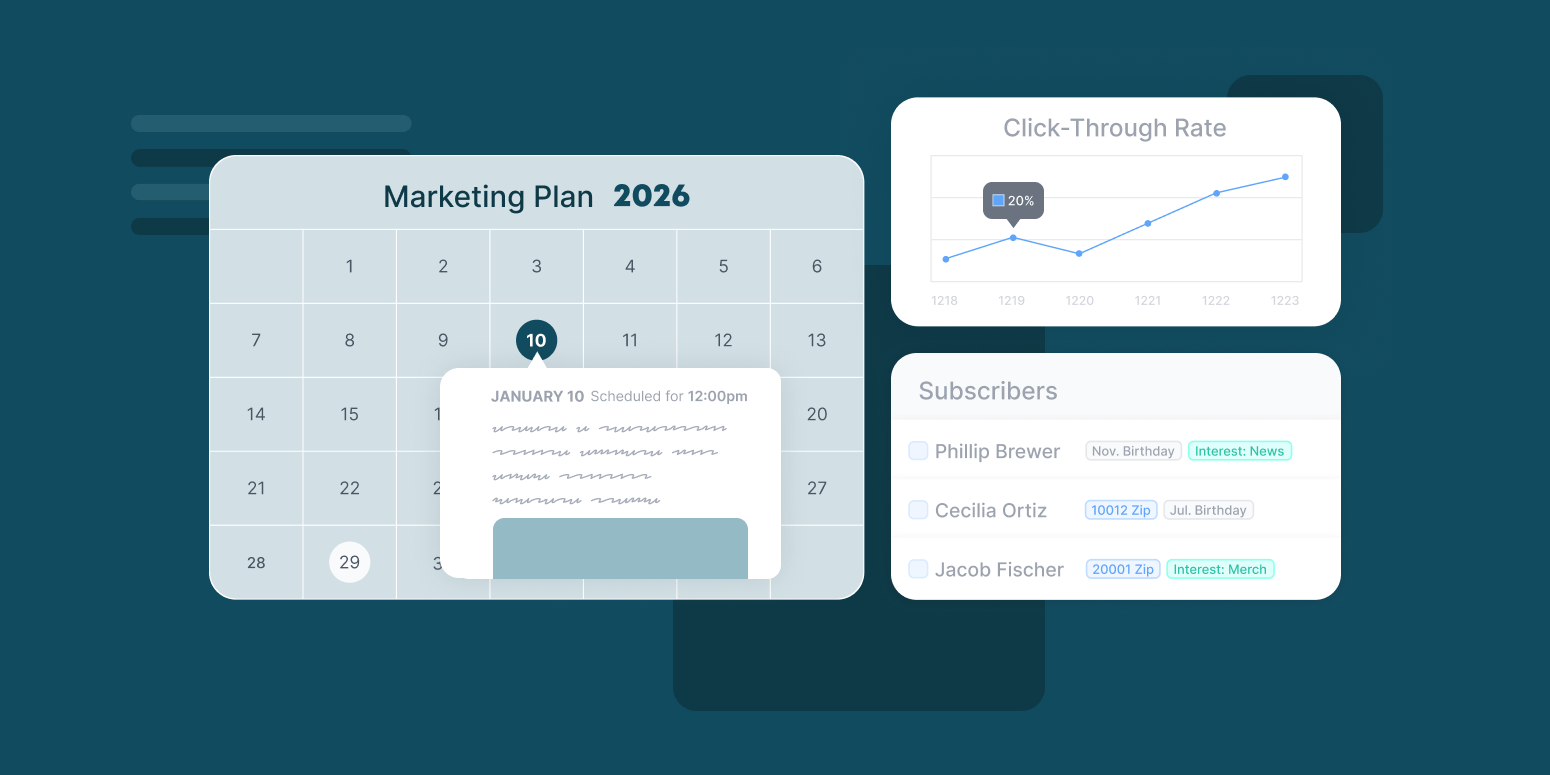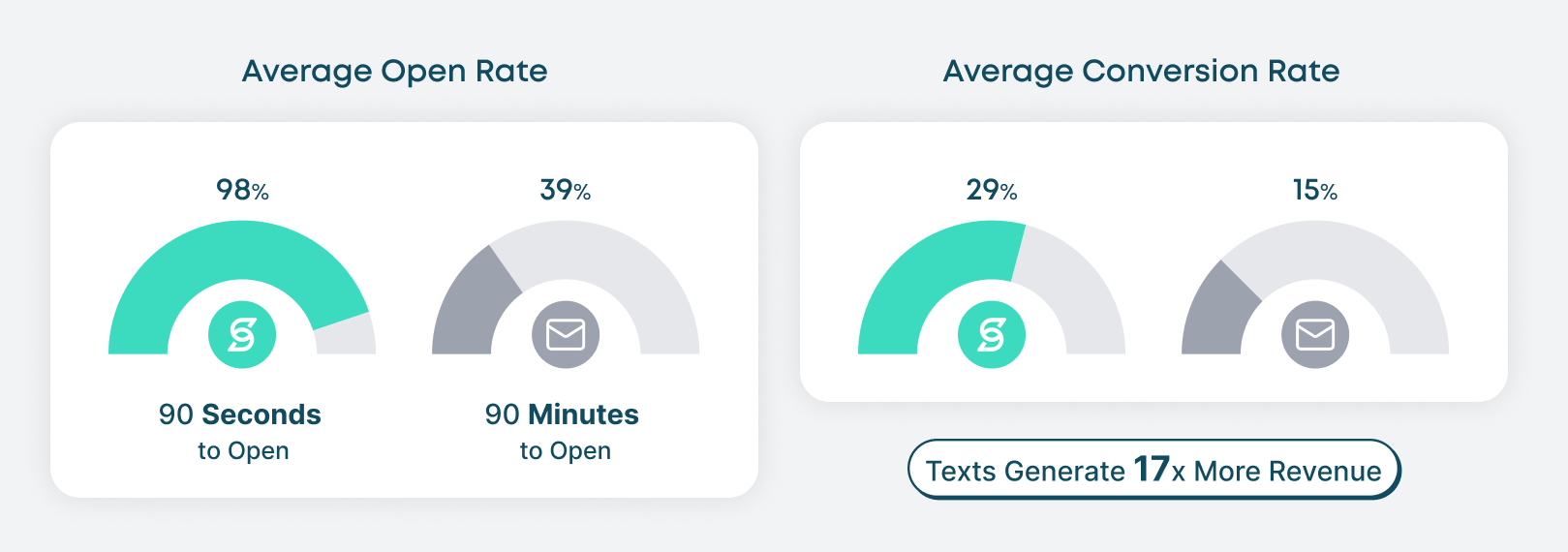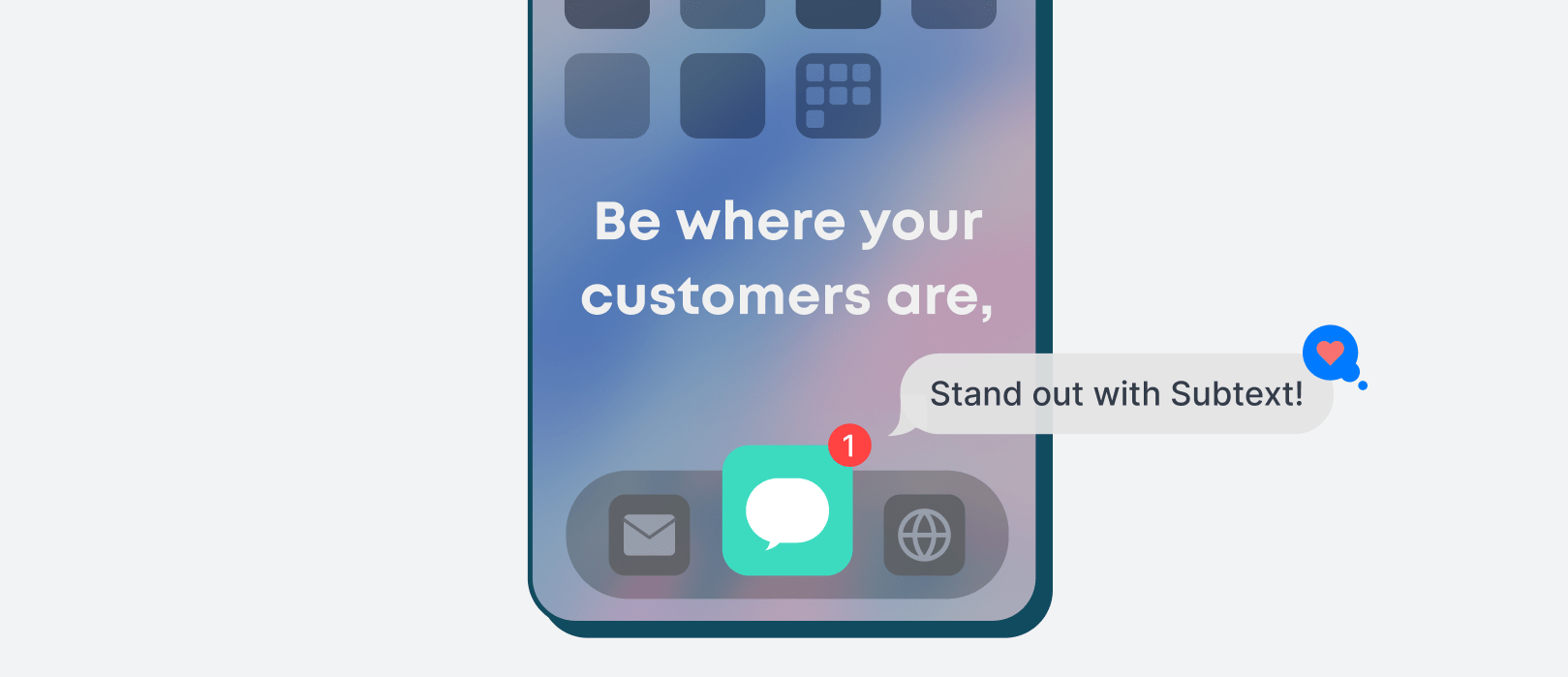
Why SMS Deserves a Place in Your 2026 Marketing Plan
It’s 2026, and marketing has never been more complex — or more impersonal.
AI has made it easy to produce endless content, but the result is sameness. Every feed, email, and campaign feels familiar, automated, and forgettable. Consumers are tuning it out.
At the same time, privacy regulations, economic pressures, and shifting cultural habits are making it increasingly difficult to reach audiences in ways that feel both effective and ethical.
That’s why the most forward-thinking marketers are focusing on outcomes, not outputs.
They’re not asking, “How do I send more messages?” They’re asking, “How do I create real connection, drive measurable engagement, and build long-term trust?”
That’s exactly where SMS shines.

SMS is personal, permission-based, and performance-driven. It’s a channel that doesn’t just communicate — it converts, it builds relationships, and it earns attention.
Key Takeaways
- Cut through AI filters and regain control. With AI Overviews rewriting search results and smart inboxes filtering messages, brands are losing visibility across traditional channels. SMS delivers your message directly, without algorithms or AI deciding who sees it.
- Privacy and permission are non-negotiable. With privacy laws tightening and consumers demanding transparency, opt-in marketing isn’t optional — it’s essential. SMS is built for consent-first engagement.
- Connection drives performance. With 98% open rates and 29% average conversion rates, SMS outperforms every other digital channel because people choose to engage.
- Efficiency matters more than ever. In a cautious economy, brands don’t need more volume — they need more impact. SMS delivers precision, not noise, driving measurable ROI.
- SMS meets people where they are. From Gen Z to global audiences, text messaging reaches consumers on the device they use most — consistently, personally, and authentically.
1. AI Overviews, Smart Inboxes, and the Fight for Visibility
AI has changed how people discover, receive, and act on information — and not always in ways that help marketers. Two major shifts are reshaping how your audience sees (or doesn’t see) your message.
AI Overviews Are Disrupting Discovery
Search isn’t what it used to be. Large language models and Google’s new AI Overviews now summarize entire web pages in a few sentences, often pulling key insights without requiring users to click through. Publishers and brands are already seeing the impact: declining referral traffic, fewer email signups, and fewer chances to convert.
Even great content can get buried under machine-generated summaries that satisfy curiosity before a visitor ever reaches your site. For marketers who depend on organic reach, that’s a seismic shift — visibility no longer depends on quality or authority alone, but on how AI decides to interpret and present your work.
AI Inboxes are Reshaping Engagement
At the same time, AI inboxes from Google and Apple are filtering and prioritizing messages automatically. These tools determine which emails are displayed, which are summarized, and which are quietly archived. Even the most well-crafted campaign can be distilled or skipped entirely before it’s ever read.
Our CEO, Mike Donoghue, explains it: “When two companies control nearly 90% of global email clients, and both are leaning into AI prioritization, it’s easy to imagine a future where users only see the ten things an algorithm says they need each day.”
The Result: Less Control, More Dependence
Between AI Overviews and AI inboxes, brands are losing the ability to control how and when they reach their audience. Discovery and delivery are now mediated by algorithms that decide what’s visible, clickable, or even necessary.
The Solution: Own the Channel
SMS cuts through both problems. It isn’t filtered by AI, summarized by an LLM, or buried in an inbox tab. It’s direct, permission-based, and immediate. When someone subscribes, your message lands in the one place they still check dozens of times a day — their phone.
Unlike algorithmic channels, SMS is a form of owned communication. You control the audience, the timing, and the message. It’s visibility that can’t be rewritten, summarized, or deprioritized by AI.
2. Privacy, Regulation, and the Power of Permission
The data environment has changed for good. Even though Google recently paused its full phaseout of third-party cookies, that reversal doesn’t mean a return to “data as usual.” What’s clear is that the future belongs to brands that build direct relationships with their audiences—through owned channels, first-party data, and permission-based marketing. These aren’t just best practices anymore; they’re essential to thriving in today’s privacy-first landscape.
Compliance Isn't a Barrier; It's an Advantage
In 2026, privacy-first marketing isn’t just about staying compliant; it’s about standing out. As inboxes and ads become more automated, people are tuning out content they didn’t explicitly ask for. SMS flips that script. Every subscriber has opted in, which means every message is expected, welcomed, and far more likely to drive action.
That built-in permission model makes SMS one of the most future-proof marketing channels out there. And with new privacy laws and carrier rules like 10DLC registration, the brands that invest in doing it right will build more durable, trusted relationships with their audiences.
Trust Is The New Currency
According to Cisco’s 2025 Data Privacy Benchmark Study, 95% of consumers say they won’t buy from a company that fails to protect their data. SMS marketing through Subtext builds that trust into every interaction. It’s consent-first, privacy-secure, and designed for the era of transparency.
When you combine permission with simplicity, you don’t just check a legal box; you earn attention that lasts.
Owning Your Audience Means Owning Your Data
First-party data is now one of a brand’s most valuable assets. SMS marketing gives you direct access to your audience, with no intermediaries, rented algorithms, or dependency on social feeds or search platforms. Every subscriber, every interaction, and every engagement belongs to you.
With Subtext, that data stays securely yours. You build a list of real people who have chosen to hear from your brand, creating a durable asset that grows in value over time. First-party data is not just a metric; it is long-term marketing equity. In a landscape where platforms change and algorithms shift, owning your audience means protecting your growth.
Subtext Makes It Easy To Do It Right
Subtext is designed to remove the friction from compliance. We handle 10DLC registration, consent management, opt-out automation, and message disclosures for you — so you can focus on what matters: sending great messages that build connection.
Our platform ensures every text you send is compliant, transparent, and carrier-approved. You’ll never need to worry about the details because Subtext already does.
3. Human Connection in an Automated Age
Automation has made marketing faster, but it hasn’t made it more meaningful.
Inboxes are crowded with templated emails, social feeds are managed by algorithms, and AI chatbots are handling customer interactions that used to be personal. Consumers feel it. According to a 2025 Salesforce State of the Connected Customer Report, 73% of customers expect better personalization from brands, yet 61% say they feel most brand interactions still lack a human touch.
That’s where SMS stands out.
A text reaches people in their most personal space. It is short, direct, and conversational, the same format they use with friends, family, and coworkers every day. If executed correctly, texts from your organization will feel personal, not promotional.
SMS open rates average 98%, compared to about 39% for email, and 29% conversion rates for texts versus 15% for email. According to Subtext’s 2025 Benchmark Report, SMS campaigns generate engagement rates more than four times higher than email. That responsiveness isn’t just about immediacy; it’s about intimacy.

Texting gives brands a way to build ongoing dialogue by sharing updates, gathering feedback, and creating moments that feel genuinely one-to-one. It is not just another campaign channel; it is a relationship channel.
Technology can automate delivery, but it cannot automate connection. SMS bridges that gap, helping brands communicate in a way that feels direct, human, and worth engaging with.
4. The Economy and the Power of Precision
Inflation, tariffs, and global uncertainty have reshaped consumer behavior in 2026. Budgets are tighter, prices are higher, and people are more deliberate about where they spend.
Across the brands we work with, we keep hearing the same thing: “We don’t need volume, we need impact.”
A slower economy has made marketing more about efficiency than expansion. Teams are rethinking success, focusing less on impressions and more on what drives action. Every dollar and every message needs to count.
That shift has led marketers to favor intentional, high-performing channels that deliver measurable results — and SMS fits that moment perfectly.
SMS reaches the right person at the right time, with relevance and context. It’s not about adding noise; it’s about precision. A restock alert, event reminder, or limited-time offer lands when intent is highest, and that timing drives conversion.
The impact speaks for itself. In The Spokesman Review case study, the publication used Subtext to re-engage subscribers whose payments were about to lapse. By sending timely SMS reminders 2–8 days before expiration, they recovered nearly $8,000 in revenue in six weeks and reactivated more than 60 subscribers per week.
That kind of return shows what happens when brands prioritize precision and trust over volume. In a cautious economy, consumers reward messages that feel relevant, not relentless — and SMS delivers exactly that.
5. Cultural and Generational Shifts
Younger audiences are changing how connection works. Gen Z and Gen Alpha don’t rely on email and are skeptical of traditional advertising. But they do respond to texts.
Nearly 49% of 18–24-year-olds say they prefer texting to phone calls. Texting feels conversational and authentic. It’s how they communicate with everyone else in their lives, which makes it a natural fit for brands they trust.
SMS works because it meets people where they already are — on the device they check constantly. It doesn’t ask for downloads, logins, or algorithmic luck. It simply shows up where attention already lives.
Globally, SMS remains one of the most reliable ways to reach people, especially in mobile-first markets. It’s universal, accessible, and independent of changing platforms or feeds.
That accessibility gives SMS staying power. As habits evolve and new platforms emerge, the simple text message continues to meet people where they are and deliver reach, relevance, and results.
Bring It All Together
Marketing will always evolve, but human behavior doesn’t change as quickly. People still want communication that feels personal, transparent, and worth their attention.
SMS is built for that.
It’s not a “back to basics” tool; it’s a modern channel that delivers trust, engagement, and measurable performance in ways AI-driven platforms can’t. It gives you the ability to connect directly with your audience, on their terms, in their most personal space.
In a landscape defined by automation and information overload, SMS helps you stay relevant, human, and high-performing. It turns communication into connection, and connection into results.

Choosing the Right SMS Platform
Not all SMS platforms are created equal. The best ones make compliance simple, deliverability strong, and audience relationships easy to manage.
When evaluating providers, look for:
- Built-in compliance tools that manage 10DLC registration, opt-ins, and “Reply STOP” automation
- Reliable deliverability with carrier-approved sending routes
- Two-way communication options that allow for replies and personalization
- Transparent reporting that shows engagement, conversion, and ROI clearly
Subtext was built to handle all of this for you. Our platform takes care of the compliance, registration, and infrastructure — so you can focus on creating messages that drive impact. Check out our SMS Platform FAQ to learn more.
That’s why SMS belongs in your 2026 marketing plan. Ready to see what SMS can do for your brand? Book a demo with Subtext.